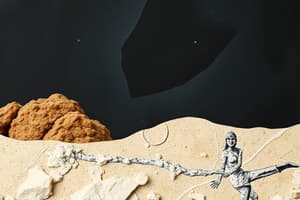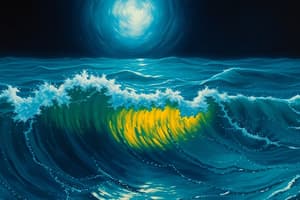Podcast
Questions and Answers
Which of the following statements accurately describe(s) the depth and height of Earth's surface as shown on the hypsographic curve? (Select all that apply)
Which of the following statements accurately describe(s) the depth and height of Earth's surface as shown on the hypsographic curve? (Select all that apply)
- The average height of land is greater than the average depth of the ocean.
- The percentage of Earth's surface above sea level is 29.2%. (correct)
- The average depth of the ocean is much greater than the average height of land. (correct)
- More people have been to the top of the tallest mountain on Earth than have been to the bottom of the deepest trench. (correct)
Why is the average depth of the ocean much greater than the average height of land?
Why is the average depth of the ocean much greater than the average height of land?
Oceanic crust is more dense than continental crust.
To which planet is NASA sending the spacecraft InSight to study crustal movements similar to earthquakes?
To which planet is NASA sending the spacecraft InSight to study crustal movements similar to earthquakes?
Mars.
Which of the following is an example of an active continental margin?
Which of the following is an example of an active continental margin?
What features are associated with a passive continental margin?
What features are associated with a passive continental margin?
What is turbidity?
What is turbidity?
What effect do turbidity currents have on the continental slope?
What effect do turbidity currents have on the continental slope?
The reason the deposit on the bottom forms the way it does is a result of __________.
The reason the deposit on the bottom forms the way it does is a result of __________.
What is the characteristic layering of an individual turbidity current deposit called?
What is the characteristic layering of an individual turbidity current deposit called?
The measurement of ocean depth and seafloor topography is called __________.
The measurement of ocean depth and seafloor topography is called __________.
What method is most frequently used to investigate sediment and rock layers of the sea floor?
What method is most frequently used to investigate sediment and rock layers of the sea floor?
What is the water depth in meters if a ship's fathometer records an echo 7.4 seconds later, and the speed of sound in water is 1,500 m/second?
What is the water depth in meters if a ship's fathometer records an echo 7.4 seconds later, and the speed of sound in water is 1,500 m/second?
Which of the following techniques can be used to map the sea floor? (Select all that apply)
Which of the following techniques can be used to map the sea floor? (Select all that apply)
Of the following statements about mapping the ocean floor, which is/are true? (Select all that apply)
Of the following statements about mapping the ocean floor, which is/are true? (Select all that apply)
Satellites use microwave beams to measure sea level to an accuracy of how many centimeters?
Satellites use microwave beams to measure sea level to an accuracy of how many centimeters?
Multibeam SONAR systems have resolution limitations in deep water because beams of sound spread out with depth.
Multibeam SONAR systems have resolution limitations in deep water because beams of sound spread out with depth.
Active continental margins are characterized by which of the following?
Active continental margins are characterized by which of the following?
The correct order of seafloor features from the coast to the mid-ocean ridge is:
The correct order of seafloor features from the coast to the mid-ocean ridge is:
Which of the following statements about Earth's hypsographic curve is/are true? (Select all that apply)
Which of the following statements about Earth's hypsographic curve is/are true? (Select all that apply)
What percent of Earth's volcanic activity, each year, takes place on the seafloor?
What percent of Earth's volcanic activity, each year, takes place on the seafloor?
In comparison with other ocean basins, major sedimentary features such as continental rises and abyssal plains are relatively rare in the Pacific due to what reason?
In comparison with other ocean basins, major sedimentary features such as continental rises and abyssal plains are relatively rare in the Pacific due to what reason?
Few abyssal plains are located in the Pacific Ocean because turbidity currents only occur along passive continental margins.
Few abyssal plains are located in the Pacific Ocean because turbidity currents only occur along passive continental margins.
The largest single volcano on Earth, Tamu Massif, occurs in which of the following oceans?
The largest single volcano on Earth, Tamu Massif, occurs in which of the following oceans?
Volcanic peaks below sea level that rise more than 1 kilometer above the deep-ocean floor and have a flattened top are called ________.
Volcanic peaks below sea level that rise more than 1 kilometer above the deep-ocean floor and have a flattened top are called ________.
What type of sedimentary layering has the largest particles at the bottom and the smallest at the top?
What type of sedimentary layering has the largest particles at the bottom and the smallest at the top?
Volcanic peaks on the deep-ocean floor with conical tops are called:
Volcanic peaks on the deep-ocean floor with conical tops are called:
Volcanic features on the ocean floor that are less than 1,000 meters tall are called:
Volcanic features on the ocean floor that are less than 1,000 meters tall are called:
Older lithosphere is destroyed in association with:
Older lithosphere is destroyed in association with:
The island of Java is an example of a volcanic island associated with volcanic activity at a ________.
The island of Java is an example of a volcanic island associated with volcanic activity at a ________.
Which of the following feature(s) is/are associated with the mid-ocean ridge? (Select all that apply)
Which of the following feature(s) is/are associated with the mid-ocean ridge? (Select all that apply)
Flashcards are hidden until you start studying
Study Notes
Earth's Surface Depth and Height
- 29.2% of Earth's surface is above sea level.
- More individuals have climbed the tallest mountain than explored the deepest trench.
- Average ocean depth significantly exceeds the average land height.
Oceanic and Continental Crust
- Oceanic crust is denser than continental crust, contributing to greater ocean depths.
NASA InSight Mission
- NASA's InSight spacecraft is studying crustal movements on Mars related to earthquakes.
Continental Margins
- Active continental margins are exemplified by the U.S. west coast and Chile's west coast.
- Passive continental margins showcase features like continental rises and flat coastal terrain.
Turbidity Currents
- Demonstrated using a large jar of water mixed with sediment.
- Turbidity refers to suspended sediment in water.
- Erosion from turbidity currents carves submarine canyons into continental slopes.
- Settling velocity determines deposit formation on the ocean floor.
- Graded bedding characterizes turbidity current deposits.
Seafloor Mapping and Techniques
- Bathymetry measures ocean depth and seafloor topography.
- Multi-beam sonar maps the seafloor within a 60 km strip.
- Precision-depth recorders use high-frequency sound waves for depth measurement.
- Hypsographic curves plot depth/elevation frequency.
- Seismic reflection profiles explore the layered ocean structure.
- Satellite measurements aid in mapping the seafloor due to surface reflection of underwater features.
Sediment and Ocean Floor Features
- Sediment layers and features in the ocean floor originate mainly from plate tectonic processes.
- Abyssal plains are flat depositional surfaces extending from continental rises.
- Seamounts are volcanic peaks on the deep ocean floor.
Ocean Trenches
- Older lithosphere is destroyed at deep-sea trenches, usually found near the Pacific Ocean.
- Most ocean trenches associate with subduction zones, exhibiting narrow or absent continental shelves.
Vicinity of the Pacific Ocean
- The Pacific Ring of Fire contains most of Earth’s active volcanoes and earthquakes due to its tectonic features.
- The Tamu Massif is the largest underwater volcano located in the Pacific Ocean.
Hydrothermal Vents and Coastal Features
- Transform faults run perpendicular to mid-ocean ridges and influence ocean floor features.
- White smokers are hydrothermal vents formed in water temperatures from 30°C to 350°C.
- Abyssal hills or seaknolls arise from volcanism and are less than 1,000 meters tall.
Miscellaneous Facts
- 85% of Earth's annual volcanic activity occurs underwater.
- Graded bedding describes sediment layering with larger particles at the bottom.
- The percentage of oceanic floor depths beyond 4,000 meters is significant according to the hypsographic curve.
- The Pacific Ocean features relatively few abyssal plains compared to other ocean basins due to sediment trapping.
Conclusion on Ocean Characteristics
- All true oceanic islands are volcanic in origin.
- The mid-ocean ridges are represented in the shallowest part of the hypsographic curve.
Studying That Suits You
Use AI to generate personalized quizzes and flashcards to suit your learning preferences.



